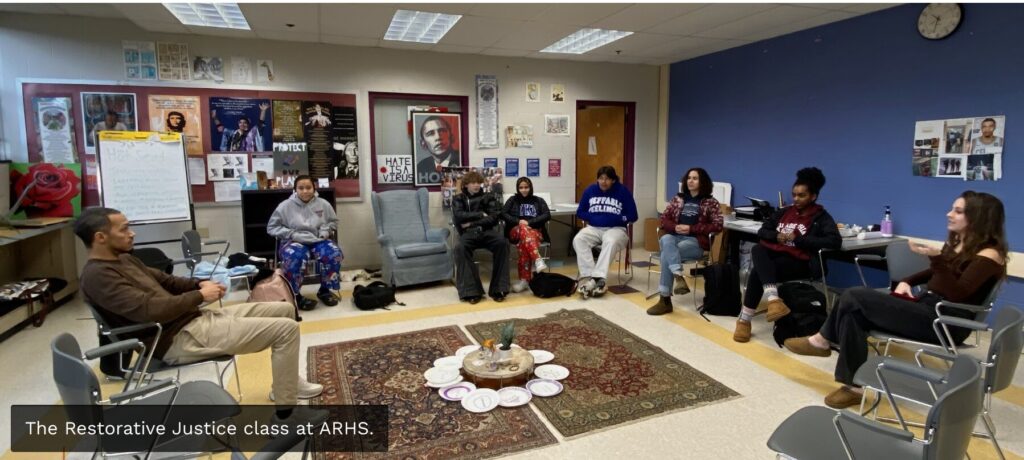Restorative Justice Working Well at ARHS. Students Opting for Class to Learn More

Photo: The Graphic
This article appeared originally in The Graphic on January 15, 2024. It is reposted here with permission.
While the use of restorative justice practices (RJ) has come under fire in recent months, specifically at Amherst Regional Middle School (ARMS), where restorative justice,was offered as sometimes the only approach to managing escalating reports of transphobic bullying, the restorative justice, program at Amherst Regional High School (ARHS) is distinct, and, by all accounts, thriving.
ARHS Restorative Justice Coordinator Aaron Buford describes restorative justice, as first and foremost a “framework that operates from the principle that relationships are a driving force in communities.” Buford is an ARHS graduate and was an ABC (A Better Chance) scholar during his four years here.
In a new ARHS class, he also teaches students all about restorative justice,, including how to communicate better, create deeper relationships, and be leaders in preventing and navigating conflicts. He works in tandem with Americorp volunteer Brianna Grundstrom in room 135, on the hallway between the main lobby and the library.
“We explore how important it is to be aware of your feelings, and be aware of how to best express yourself,” said Grundstrom.
In restorative justice,, Buford said there are three domains: community-building circles, conflict transformation, and reentry.
“Circles” center around sitting in literal circles with others, talking, connecting, and building relationships, so people feel support in classrooms and in community with others, he said. “This allows for work to be done in a way that builds on people’s strengths,” said Buford.
When there are problems at school, conflict transformation can happen using restorative justice, but all parties have to be willing and eager to use the practice to resolve harm.
Buford and Grundstrom said they “leverage relationships to better understand what happened [to cause conflict], the roles everyone played, and the impacts of the actions and words.” For example, if a student and teacher are not getting along, the restorative justice team makes sure everyone’s voice is heard and that there’s an effort made to “achieve compatibility and right the dynamic.”
Last but not least, reentry refers to the process of a student coming back to school after a suspension or any other challenging event that disrupts being at school. “If a student has been suspended, we work with the student, their family, and staff to find the best plan of support,” said Buford.
The restorative justice team works separately from the deans but they are in communication. They make decisions together with a common goal in mind: “find what will be most beneficial and supportive for all involved parties,” said Buford.
“Students are learning that restorative justice is an alternative form of conflict resolution,” said Grundstrom. “We break down conflict, starting from scratch and working our way up. Everyone comes together to express their feelings in a healthy, positive way.”
The students in the Restorative Justice class learn about how restorative justice is used in different facets of society, such as education, healthcare, criminal justice, and communities. Students in the restorative justice class, Sam Cavanagh and Autumn Tarbox, would like to see restorative justice becoming a common practice in the world.
“It’s a great way to resolve problems without placing blame on anyone,” said Cavanagh. “Everyone is involved within the solution, and you have a chance to grow from your mistakes,” Tarbox added.
Cavanagh said his favorite part of the class is the community environment. “Before this class, I didn’t know a lot of the people in the class, but now it feels like a family. Everybody gets along really well and is interacting in the circle,” he said.
The class starts with an opening circle, which sometimes has a theme, but other times remains open-ended. The students often lead it, teaching them how to facilitate community circles. Efforts are made to ensure everyone in the circle feels comfortable. “Everyone feels that they can engage freely, and everyone is respected within the circle,” Tarbox said.
“A cool thing is that everyone is assigned to do a different circle every day, so you can get everyone’s ideas,” said Grundstrom. “Everyone gets really into answering the questions and the discussion.”
After the class, Buford hopes they will “feel empowered because they have the tools to navigate conflict that maybe they didn’t have before.”
“They will learn how to walk towards conflict, not avoid it, and they have a greater sense that good can come from it,” Buford said. Another goal for the class is to get students to a point where they can lead a conflict resolution, which may, in turn, help them more fully express themselves and their opinions in the world at large.
Buford wishes everyone could learn about restorative justice at a young age. “But people have to be ready and willing to participate in the process for it to be effective,” said Buford.
Note: Sophia Rau is a senior at Amherst Regional High School and a student in Sara Barber-Just’s Journalistic Writing class.
